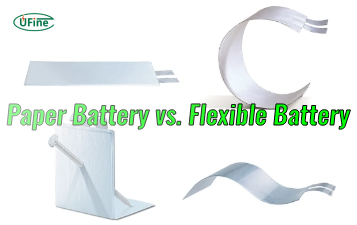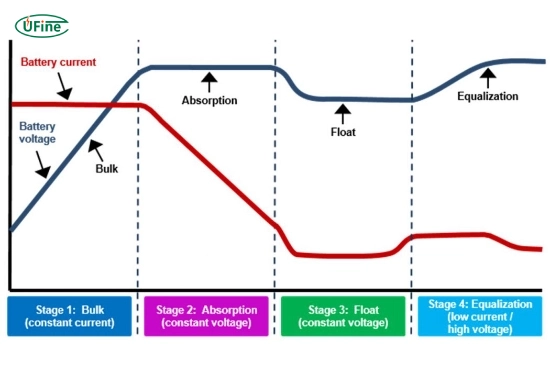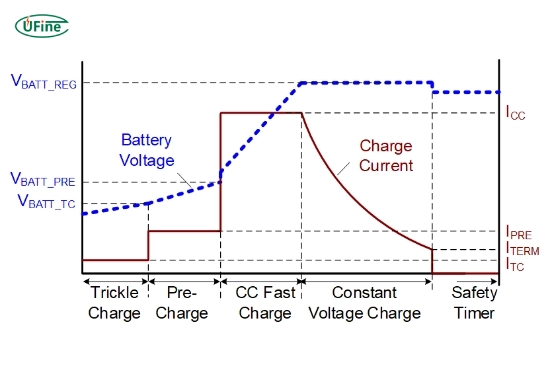Keeping your lithium batteries healthy isn’t just about charging them—it’s about correctly. One of the most critical but often overlooked methods is using float charging. If you want to extend your battery’s life, avoid costly replacements, and keep your devices running longer, you’ve come to the right place.
In this guide, we’ll explain everything you need to know about float battery charging. Whether you’re using lithium batteries for solar energy, RVs, boats, or backup systems, this article will help you understand how to keep your batteries in peak condition.
Part 1. What is a float battery?
A float battery refers to a battery that is kept at full charge by supplying it with a constant low voltage. This method is used mainly in standby power systems, solar setups, and RV battery banks to keep the battery charged without overcharging.
What is float charging?
Float charging maintains a battery at full charge by applying a voltage equal to the battery’s self-discharge rate. This helps keep the battery ready to use while reducing wear and tear.
Part 2. Why is float charging necessary for lithium batteries?
Lithium batteries are known for their long life, lightweight, and high energy density. But they’re also sensitive. Incorrect charging methods, especially overcharging or deep discharging, can damage them.
Float charging helps by:
- Preventing overcharge
- Reducing heat buildup
- Extending battery life
- Maintaining readiness for use
Using the right float voltage ensures that your battery remains healthy and efficient.
Part 3. How does float charging work?
Here’s a quick breakdown:
- The battery is fully charged.
- The charger switches to float mode.
- A low voltage (usually around 13.4V to 13.6V for a 12V lithium battery) is applied.
- The battery receives just enough power to counteract self-discharge.
This method benefits standby applications like solar battery banks or backup power systems.
Part 4. What is the ideal float voltage for lithium batteries?
This is one of the most common questions, and for good reason.
✅ Best float voltage for a 12V lithium battery:
13.4V to 13.6V
Going above or below this range might not destroy your battery right away. Still, it can reduce battery life or cause uneven cell balancing over time.
Tip: Always check the manufacturer’s recommendation for float voltage. Some lithium batteries don’t require float charging and prefer to be disconnected once full.
Part 5. Float charging vs trickle charging: What’s the difference?
It’s easy to confuse float charging with trickle charging, but they differ.
| Feature | Float Charging | Trickle Charging |
|---|---|---|
| Voltage | Controlled and stable | Can fluctuate |
| Purpose | Maintain full charge | Continuously charge |
| Battery Type | Ideal for lithium and lead-acid | Better for lead-acid |
| Risk of Overcharge | Very low | Higher if not regulated |
Float charging is safer and smarter for lithium batteries because it’s designed to maintain, not push, power.
Part 6. How to set up a float charger for lithium batteries
To get started, you’ll need:
- A smart lithium-compatible charger
- Access to your battery’s technical specs
- A voltmeter for accuracy
Steps:
- Connect the charger to the battery.
- Set the float voltage to the recommended level (e.g., 13.5V).
- Ensure the charger switches to float mode automatically after bulk charging.
- Monitor temperature and battery voltage regularly.
A good charger will do most of the work, but it’s always smart to double-check.
Part 7. Common mistakes to avoid when float charging
Avoid these float charging pitfalls to keep your battery healthy:
- ❌ Using a non-lithium charger
- ❌ Setting the wrong float voltage
- ❌ Leaving the battery on charge for months without monitoring
- ❌ Ignoring temperature effects (too hot or cold)
Pro tip: Invest in a Battery Management System (BMS) to regulate voltage and temperature automatically.
Part 8. Can you float-charge lithium batteries indefinitely?
This question is great, especially for those using solar or RV systems.
✅ Short answer:
Yes, but only if the charger and battery are designed for it.
Some lithium batteries are built for standby use and can stay in float mode for months. Others should be disconnected after charging.
Always refer to your battery’s manual. Leaving the battery on float charge indefinitely without proper specs can cause:
- Capacity loss
- Cell imbalance
- Overheating
Part 9. How temperature affects float charging?
Temperature plays a big role in charging.
- High heat can speed up chemical reactions, leading to faster degradation.
- Cold temps can slow charging and damage cells if charging continues.
Most smart chargers have temperature compensation, which adjusts the float voltage based on ambient temperature.
Ideal range for float charging lithium batteries:
10°C to 30°C (50°F to 86°F)
Part 10. Best practices to extend lithium battery life with float charging
Here’s a quick checklist of pro tips to make your lithium battery last:
- ✅ Use a smart charger with float mode
- ✅ Set float voltage to 13.4V–13.6V (for 12V batteries)
- ✅ Avoid charging in extreme temperatures
- ✅ Don’t leave batteries in 100% charge state for too long
- ✅ Monitor battery performance monthly
Remember: A little care goes a long way. Float charging the right way can double your battery’s lifespan.
Artikel Terkait: How to Make My Battery Last Longer?
Part 11. FAQs about float battery charging
Can I float charge any lithium battery?
No. Some lithium batteries, especially those without built-in BMS, are not designed for float charging. Always check the manufacturer’s specifications.
What charger do I need for float charging?
You’ll need a lithium-compatible smart charger to enter float mode and hold a constant voltage without overcharging the battery.
Is float charging safe?
Yes, if done correctly. Float charging at the right voltage is one of the safest ways to keep a battery fully charged without damage.
How long can I leave a battery on float charge?
It depends. Some batteries are designed for continuous float (like in backup systems), while others should be disconnected after a full charge. Follow the battery’s manual.
Will float charging fix a dead battery?
No. Float charging won’t revive a dead battery. It’s meant to maintain a healthy battery, not recover a damaged one.
Related Tags:
More Articles

Paper Battery vs. Flexible Battery: What’s the Difference and Which Is Better?
Paper vs. flexible batteries: learn the key differences, benefits, and which power source fits best for wearables, sensors, and smart tech.
What to Know Before Buying a Tiny LiPo Battery for Your Project
Tiny LiPo batteries are powerful and compact. Learn how to choose the right one for your project with specs, safety, and charging tips.
Bloated LiPo Battery: Will It Explode?
Will a bloated LiPo battery explode? Discover the causes, risks, safety steps, and expert tips to avoid disaster and protect your gear. Must-read safety guide!
12V 100Ah Lithium Ion Battery Price: Full Guide
Learn about 12V 100Ah lithium-ion battery price, from cost ranges to best brands, hidden fees, and how to get the best deal. A must-read for smart buyers!
Resistance and Conductivity: What It Means for Your Lithium Batteries
Resistance and conductivity impact lithium battery performance, lifespan, and safety—learn how they work and why they matter.






